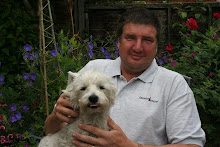 |
| Tamworth variety pork shoulder cut. |
Was it worth it, then, our first 'go' at keeping pigs? The short answer would definitely be 'Yes' and the proof of the pudding, if you like, is that we will be doing it again next year, possibly with the Berkshire breed. Last night we cooked up our first roasting joint from these 'pilot trial' pair, a shoulder cut, butchered to be around 2 kg. Liz deliberately cooked it in just oil and salt so that we'd get the full, unadulterated flavour. It was a great success - delicious, succulent meat of gorgeous flavour and superb tenderness. The eating experience alone would probably have us trying again in 2015, but I'll give you a bit more waffle around that, if you're interested.
 |
| The same cut, resting from the roast. |
You can see from the picture that the joint had the expected 'traditional breed' good inch thick layer of fat below the skin. These days we pretty much chuck that, so Liz would 'peel' off the outer skin to quick-roast for the crackling, and I'd be trimming off more at carving time, but that's just modern taste. These breeds were really all about putting on that fat layer to produce fatty meat and bacon , fat is flavour after all, and back in the day, your physically hard-working farmers would have consumed it all hungrily as a way of getting their 3000 calories a day sustenance. Now, with Tamworths, we know that you can reduce the pig's food amount at 16 weeks and put them on a 'maintenance diet' up to slaughter to stop too much fat being laid down, or you can fatten them up us baconers and happily take the 2 inch thick fat layer. We tried for a result closer to the 'slim' end, though I admit I was too much the softie to resist these girls loud squealed appeals that they were STARVING! I was probably over-feeding just to stop them plaguing me.
 |
| Carved result. We did it justice! |
Certainly in terms of enjoyment it was worth it. Regular readers will know that I was sure we'd not 'do' pigs because I wasn't sure we could fence them in, or feed them cheaply enough, or learn to love them. A friend (no names no pack drill) had ended up hating their animals and being so scared of being bitten or barged that feeding at the end was by chucking milled barley over a stable door without daring to go into their pen. Another friend, contrarily, thought we might fall so in love with them that we'd not be able to take them to the abattoir and we'd be left with these expensive pets for decades.
 |
| The young Buffs enjoy perching on the gate. |
Well, I was totally charmed, I must admit, from the moment we set eyes on our two in a crate at the supplier's farm and I did learn to love them and was never scared. I could go into the pen throughout and scratch their backs, measure them with the tape measure, pulled a grass tick off one, rubbed their muddy ear-tags clean with my thumb and so on. I only got one bite and that when I foolishly waved 2 apples at 2 pigs through the fence but then focused only on getting one apple accurately into the one pig's mouth. The 2nd pig got impatient at her apple being waved vaguely in front of her while I wasn't concentrating, and took a snapping lunge at it. She almost ended up with some finger mixed in with her fruit, but she didn't draw blood and it was my fault. The pigs were superbly biddable through-out and easily trained to follow the feed bucket. So I loved them in the sense of respecting them, protecting them and wanting them to have a good, stress free, happy life and stopping anything or anyone doing them any harm, but I always got the impression that they didn't really 'love' me back; they seem to be 100% mercenary - if you had food or a back-scratch on offer, they'd stick to you like glue, but otherwise they'd have no interest in you at all. I was always sufficiently detached that the 'expensive pets' thing was never going to happen.
 |
Warming stuff. A nice gift of flavoured
poitín "to sort my cold out" from the van
owned by a shopkeeper to whom I
got talking! Only in Ireland? |
In terms of money, they worked out OK, all be it only in our 'Mickey Mouse' accounts system were proper farm costs like land, fencing and labour are ignored. Putting in the costs for the piglets initially, pig-nuts, fruit, slaughter and butchery, we came up with a cost per kg of finished meat, of €4.84. This is, I know, a lot more than Anne and Simon managed (they got most of their fruit for free and did their own butchery) but is still excellent against the current supermarket prices, even the cheaper 'commercial' (intensively reared, indoor housed) pork and is brilliant against anything high welfare, outdoor reared and traditional breed. We're happy with it, anyway and we have, of course, the added bonuses of knowing what went into our pigs and what a happy, carefree life they lived
 |
| Happy Hallowe'en. |
If there are downsides, I can think of a couple of unexpected ones. First there is the sheer amount of meat you get and have to then 'deal with'. I had gone through the process fending off requests for 'half a pig' or a whole carcass. We only had two, I said, and we want to get a good taste out of them, so we could try out the brawn, some bacon-curing, maybe a ham or some salami. I didn't want to sell it all and be left with none to 'play with'. As you know, I ended up with 7 boxes of meat (124 kg!) from the two animals and nearly ran out of space in the freezer(s) and now wish I'd found homes for some in advance. There was also the constant nagging worry that they'd tunnel out or break through the fences. All the advice we'd been given said you NEED electric fences but I was clinging to the paragraph in my Haynes 'bible' (Liz Shankland's Pig Manual) saying that a strand of barbed wire added along the bottom of sheep fence would suffice. I gritted my teeth and prayed that the pigs would not break out and send me running to the electric fence crowd with my tail between my legs. It was a relief to get to abattoir day with no escapes and to now trust the 'Shankland' fences at last. Finally there was that loud, insistent squealing for food. I wound up unable to go visit the geese or bees, or sometimes the yard without one of them spotting me and starting to shout. It's not a good noise and a bit annoying especially if you KNOW they have just been fed. I loved their quiet contented grunting when they were getting their own way, but I was happy to lose the squealing!
Yes, on balance it was definitely worth it and we will be back in 2015 for the 2nd chapter.








4 comments:
Like the pumpkin heads, I will be making pumpkin pie from the one that you gave us.
Just to clarify for the readers, Anne is referring to the Red Kuri Squash we grew, which we are eating. The 'pumpkin heads' were genuine pumpkins we bought from the supermarket for the lantern-making. We don't waste our good Kuri on Hallowe'en. Incidentally, the chickens turn out to love the pumpkin centres, especially pulling out the big, flat seeds.
Pumpkin seeds are a natural wormer Matt.
Now THERE's a bonus!
Post a Comment